|
|
|
When we speak of the fall of the Roman Empire, we should not
forget that in fact only the western portion of that empire succumbed to the
Germanic invaders. In the east, the eastern Roman, or Byzantine (Greek) Empire
stood for a thousand years as a citadel against the threats of expansion by
the Asian invaders.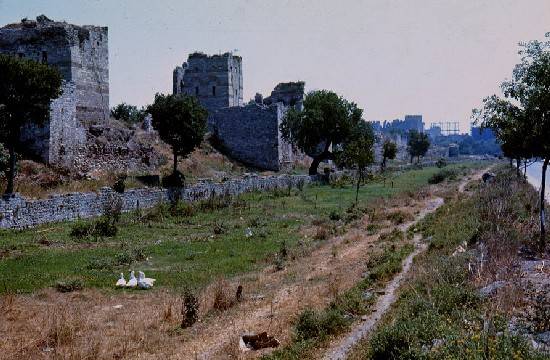 The Walls
The Walls
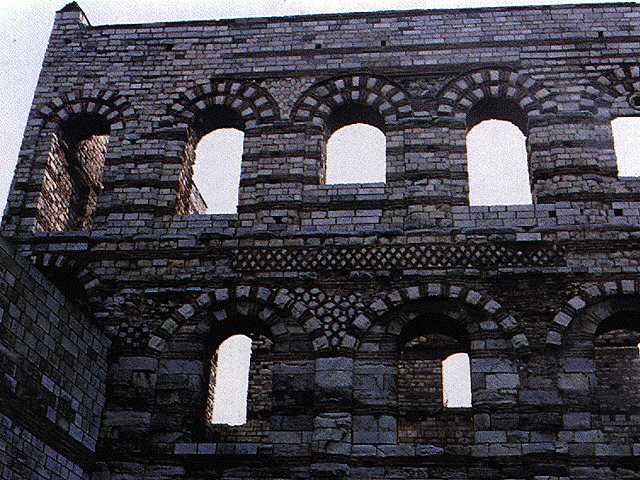 The Byzantine Empire made great contributions to civilization: Greek language,
culture and learning were preserved for posterity; the Roman imperial system
was continued and Roman law codified; the Greek Orthodox church converted the
Slavs and fostered the development of a splendid new art dedicated to the glorification
of the Christian religion. Situated at the crossroads of east and west, Constantinople
acted as the disseminator of culture for all peoples who came in contact with
the empire. Called with justification "The City," this rich and turbulent metropolis
was to the early Middle Ages what Athens had been to classical times. By the
time the empire collapsed in 1453, its religious mission and political concepts
had borne fruit among the Slavic peoples of eastern Europe and especially among
the Russians. The latter were to lay claim to the Byzantine tradition and to
call Moscow the "Third Rome." Also the byzantine intellectuals, after 1453,
spread to the western Europe the ancient spirit of Plato and Aristotle, setting
so the basis for the Renaissance.
The Byzantine Empire made great contributions to civilization: Greek language,
culture and learning were preserved for posterity; the Roman imperial system
was continued and Roman law codified; the Greek Orthodox church converted the
Slavs and fostered the development of a splendid new art dedicated to the glorification
of the Christian religion. Situated at the crossroads of east and west, Constantinople
acted as the disseminator of culture for all peoples who came in contact with
the empire. Called with justification "The City," this rich and turbulent metropolis
was to the early Middle Ages what Athens had been to classical times. By the
time the empire collapsed in 1453, its religious mission and political concepts
had borne fruit among the Slavic peoples of eastern Europe and especially among
the Russians. The latter were to lay claim to the Byzantine tradition and to
call Moscow the "Third Rome." Also the byzantine intellectuals, after 1453,
spread to the western Europe the ancient spirit of Plato and Aristotle, setting
so the basis for the Renaissance.
At the distance of many centuries and thousands of miles, the civilization of
the Byzantine Empire presents an appearance of unity. This unity was ensured
from the Orthodoxy and from the Greek culture or pneuma a pneuma which was the
continuation of the ancient Greek spirit. However the development of Byzantine
civilization had two other influences: the first was Roman and the second was
Oriental. Asia Minor was the heart of the empire. 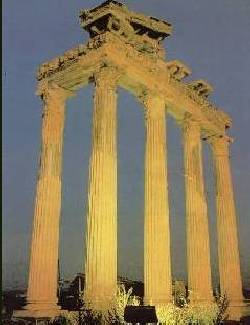 In the east of Asia Minor the population was Armenian, in southeast it was Assyrian
and in the south it was Syrian. The coast lands of Asia Minor and the northern
part (Pontus) were Greek. The Greeks existed in Mikra Asia thousands years B.C,
as their mythology and ancient history testifies.
In the east of Asia Minor the population was Armenian, in southeast it was Assyrian
and in the south it was Syrian. The coast lands of Asia Minor and the northern
part (Pontus) were Greek. The Greeks existed in Mikra Asia thousands years B.C,
as their mythology and ancient history testifies.
The western part of the empire was comprised of Thrace, Macedonia,
Epirus, Peloponnese, Thessaly,
Aegean
islands, Sicily, areas inhabited by Greeks from thousands years B.C. But
those areas always had been the target of immigration of other nations through
the long course of Greek history. In the sixth century the Slavs began to spread
over the Balkan Peninsula. Albanians, from the beginning of the fifteenth century
spread also southern and reached even Peloponnese. Bulgars gradually became
incorporated with the Slavs, and spread into Macedonia. As mentioned before,
the Greeks were the predominant race in the empire. The ancient Greek city of
Byzantium stood at a promontory that juts out from Europe toward Asia, into
Bosporus, with the Sea of Marmara to the south and a long harbor known as the
Golden Horn to the north. On this peninsula Constantine the Great had
chosen the site for his new capital, New Rome . He placed Constantinople
on the frontier of Europe and Asia, dominating the waterway connecting the Mediterranean
and Black seas. The byzantine fleet
was invincible; Mediterranean and the Euxenus
Pontus (Black Sea) were byzantine lakes.
From the second half of the sixth century, Latin had ceased to be the language
of the Government. The legislation eventually became thoroughly Greek, both
in language and spirit. The empire preserved a great centralized economic system
and a sophisticated network of transportations and communications. Even today,
there are remains of the Via Egnatia, connecting Constantinople with the Adriatic
Sea through Thessalonica, and of the great military roads through Asia Minor,
from Chalcedon past Nicomedia, Ancyra and Caesarea, to Armenia, as well as of
that from Nicaea through Dorylaeum and Iconium to Tarsus and Antioch.
The security and wealth provided by its setting helped Byzantium survive for
more than a thousand years. Constantinople was a state-controlled, world trade
center which enjoyed the continuous use of a money economy - in contrast to
the localized systems found in the west. The city's wealth and taxes paid for
a strong military force and financed an effective government. 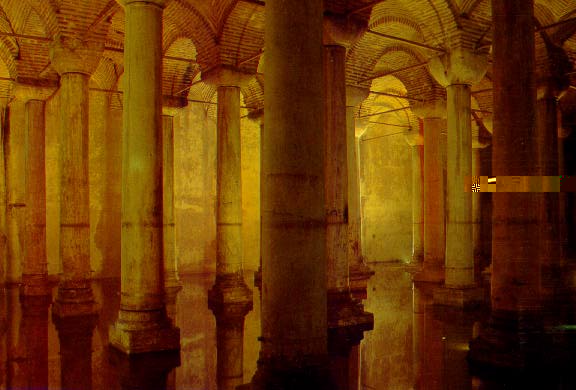 Excellent sewage and water systems supported an extremely high standard of living.
Food was abundant, with grain from Egypt, fruits and vegetables from Minor Asia,
fish from the Aegean. Constantinople could support a population of a million,
at a time when it was difficult to find a city in Europe that could sustain
more than 50,000.
Excellent sewage and water systems supported an extremely high standard of living.
Food was abundant, with grain from Egypt, fruits and vegetables from Minor Asia,
fish from the Aegean. Constantinople could support a population of a million,
at a time when it was difficult to find a city in Europe that could sustain
more than 50,000.
Unlike Rome, Constantinople had several industries producing luxury goods, military
supplies, hardware, gems, jewelry, rich textiles, furs, aromatic spices, and
drugs. After silkworms were smuggled out of China about A.D. 550, silk production
flourished and became a profitable state monopoly. The state paid close attention
to business, controlling the economy: A system of guilds to which all tradesmen
and members of the professions belonged, set wages, profits, work hours, and
prices and organized bankers and doctors into compulsory corporations. The commercial
activity was the bigest of the middle ages; the Byzantines offered to India,
Persia, and Central Asia a channel of communication with the West. Various districts
of the empire strove to promote the export of industrial articles, Syria and
Egypt, in particular, upholding their ancient positions as industrial sections
of importance, their activity expressing itself chiefly in weaving and dyeing
and the manufacture of metals and glass. As early as the sixth century Constantinople
had a system of street-lighting; sports, equestrian games or polo-playing, and
above all races in the circus attained a high national and political importance;
Byzantine princesses married to Venetians introduced the use of table forks
in the West. More striking are the facts that as early as the eighth and ninth
centuries, the Byzantines, in their wars with the Arabs, used gunpowder — the
so-called Greek fire, Hugron Pir.
In the tenth and eleventh centuries weaving, embroidery, and the fabrication
of carpets were of considerable importance at Thebes and Patrae. In the capital
itself, with government aid in the form of a monopoly, a new industrial enterprise
was organized which confined itself chiefly to shipbuilding and the manufacture
of arms in the imperial arsenals but also took up the preparation of silk fabrics.
The Byzantines themselves, in the earlier periods, carried these wares to the
West. There they enjoyed a commercial supremacy for which their only rivals
were the Arabs and which is most clearly evidenced by the universal currency
of the Byzantine gold solidus. The
widespread literacy and education among men and women of various segments of
society would not be matched in Europe until, perhaps, eighteenth-century, France.
Until its fall in 1453, the Byzantine Empire remained a shining fortress, attracting
both invaders and merchants.
Constantine the Great and his successors struggled to renew the empire.
Rome collapsed under the pressure of the Germanic invaders in 476. Justinian
(527-565) was the last emperor to attempt seriously to return the Roman Empire
to its first-century grandeur. Aided by his forceful wife Theodora and a corps
of competent assistants, he made lasting contributions to Western civilization
and gained short-term successes in his foreign policy.
The damage caused by devastating earthquakes (a perennial problem in the area)
in the 520s and 530s gave Justinian the opportunity he needed to carry out a
massive project of empire-wide urban renewal. He strengthened the walls defending
Constantinople and built the Church of
the Holy Wisdom, which still stands in the city. The dome of the church
is an architectural triumph with forty windows circling its base, producing
a quality of light that creates the illusion that the ceiling is floating.
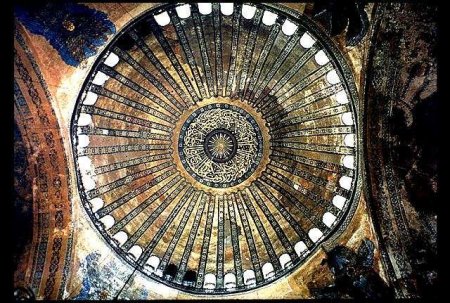
Ioustinianus reformed the
government and ordered a review of Roman law. This undertaking led to the publication
of the Code of Justinian, a digest of Roman and church law, texts, and other
instructional materials that became the foundation of modern Western law. He
had received an excellent education. He might justly be called a scholar; at
the same time he was a man of boundless activity. As absolute monarch, he developed
an almost incredible capacity for work. He endeavoured to master all the departments
of civil life, to gather in his hands all the reins of government. The number
of rescripts drawn up by Justinian is enormous. They deal with all subjects,
though towards the end by preference with dogmatic questions, as the emperor
fancied that he could put an end to religious quarrels by means of bureaucratic
regulations. He certainly took his vocation seriously. On sleepless nights he
was frequently seen pacing his apartments absorbed in thought. Justinian also
participated actively in the religious arguments of his day.
The emperor's expensive and ambitious projects triggered outbreaks of violence
among the political gangs of Constantinople, the circus crowds of the Greens
and Blues. Since ancient times city dwellers throughout the Mediterranean formed
groups, each pursuing a set of economic, social, and religious goals. Much like
contemporary urban gangs, members of the circus factions moved about in groups
and congregated at public events.
In Constantinople the Circus took place in the Hippodrome, a structure that
could hold 80,000 spectators. There contests of various types were held, including
chariot races. The Blues and Greens backed opposing drivers and usually neutralized
each other's efforts. In 532, however, the Blues and Greens united to try to
force Justinian from the throne. The so-called Nike rebellion Stasis tou
Nika, named after the victory cry of the rioters, nearly succeeded. In his
Secret Histories, Procopius relates that Justinian was on the verge of running
away, until Theodora stopped him and told the frightened emperor:
I do not choose to flee. Those who have worn the crown should never survive
its loss. Never shall I see the day when I am not saluted as empress. If you
mean to flee, Caesar, well and good. You have the money, the ships are ready,
the sea is open. As for me, I shall stay.
Assisted by his generals: Narses and Velissarius, the emperor remained
and put down the rebellion. To carry out his plan for regaining the lost half
of the empire from the Germanic invaders, he first had to buy the neutrality
of the Persian kings who threatened not only Constantinople but also Syria and
Asia Minor. After securing his eastern flank through diplomacy and bribery,
he took North Africa in 533 and the islands of the western Mediterranean from
the Vandals.
The next phase of the conquest was much more exhausting. Like warriors before
and after him, Justinian had a difficult time taking the Italian peninsula.
After twenty years, he gained his prize from the Ostrogoths, but at the cost
of draining his treasury and ruining Rome and Ravenna. Justinian's generals
also reclaimed the southern part of Spain from the Visigoths, but no serious
attempt was ever made to recover Gaul, Britain, or southern Germany.
 By a decade after Justinian's death, most of the reconquest had been lost. The
Moors in Africa, Germanic peoples across Europe, and waves of Asiatic nomadic
tribes threatened the imperial boundaries. Ancient enemies such as the Persians,
who had been bribed into a peaceful relationship, returned to threaten Constantinople
when the money ran out. In addition, the full weight of the Slavic migrations
came to be felt. Peaceful though they may have been, the primitive Slavs severely
strained and sometimes broke the administrative links of the empire. Finally,
the empire was split by debates over Christian doctrine. Two of Justinian's
successors succumbed to madness under the stress of trying to maintain order
in the empire.
By a decade after Justinian's death, most of the reconquest had been lost. The
Moors in Africa, Germanic peoples across Europe, and waves of Asiatic nomadic
tribes threatened the imperial boundaries. Ancient enemies such as the Persians,
who had been bribed into a peaceful relationship, returned to threaten Constantinople
when the money ran out. In addition, the full weight of the Slavic migrations
came to be felt. Peaceful though they may have been, the primitive Slavs severely
strained and sometimes broke the administrative links of the empire. Finally,
the empire was split by debates over Christian doctrine. Two of Justinian's
successors succumbed to madness under the stress of trying to maintain order
in the empire.
Salvation from the Arab peril came through the energetic dynasty of Heraclius,
which flourished for five generations. Three of the rulers were characterized
by extraordinary will power and striking intellectual ability: Heraclius
(610-641), Constans (642-668), and Constantine IV, called Pogonatus, or the
Bearded (668-685). Heraclius
(610-641), the Byzantine governor of North Africa, returned to Constantinople
and overthrew the mad emperor Phocas. Conditions were so dismal and the future
appeared so perilous when Heraclius arrived in the capital that he considered
moving the government from Constantinople to Carthage in North Africa.
The situation did not improve soon. The Persians marched through Syria, took
Jerusalem - capturing the "True Cross" - and entered Egypt. When Egypt fell
to the Persians, the Byzantine Empire lost a large part of its grain supply.
Two Asiatic invaders, the Avars and the Bulgars, pushed against the empire from
the north. Pirates controlled the sea lanes and the Slavs cut land communication
across the Balkans. At this moment of ultimate peril, the emperor decided to
throw out the state structure that had been in place since the time of Diocletian
and Constantine.
Heraclius created a new system that strengthened his army, tapped the support
of the church and people, and erected a more efficient, streamlined administration.
He determined that the foundation for the redefined empire would be Minor
Asia (present-day Turkey) and that the main supply of soldiers for his army
would be the free peasants living there, rather than mercenaries. In place of
the sprawling realm passed on by Justinian, Heraclius designed a compact state
and an administration conceived to deal simultaneously with the needs of government
and the challenges of defense.
Heraclius' system, known as the theme system, had been tested when the emperor
had ruled North Africa. Acting on the lessons of the past four centuries, he
assumed that defense was a constant need and that free peasant soldiers living
in the theme (district) they were defending would be the most effective and
efficient force. He installed the system first in Minor
Asia, and his successors spread it throughout the empire for the next two
centuries. Heraclius' scheme provided sound administration and effective defense
for half of the cost formerly required. As long as the theme system with its
self-supporting, land-owning, free peasantry endured, Byzantium remained strong.
When the theme system and its free peasantry were abandoned in the eleventh
century, the empire became weak and vulnerable.
 Heraclius fought history's first holy war to reclaim Jerusalem from the Persians.
By 626 he stood poised to strike the final blow and refused to be distracted
by the Avar siege of Constantinople. He defeated the Persians at Nineva, marched
on to Ctesiphon, and finally reclaimed the "True Cross" and returned it to Jerusalem
in 630.
Heraclius fought history's first holy war to reclaim Jerusalem from the Persians.
By 626 he stood poised to strike the final blow and refused to be distracted
by the Avar siege of Constantinople. He defeated the Persians at Nineva, marched
on to Ctesiphon, and finally reclaimed the "True Cross" and returned it to Jerusalem
in 630.
Then came the fearful reverses consequent on the Arab rising; in 635 Damascus
fell; in 637 Jerusalem was surrendered by the Patriarch Sophronius, after a
siege of two years. At first (634) Heraclius himself came to Antioch to organize
the campaign, then followed the lethargy due to his sickness, and he supinely
allowed the Arabs to advance. At his death (641) Egypt was virtually lost; in
647 Alexandria fell into the hands of the Arabs, and her famous greek libraries
were burnt. Meanwhile the Arabs had built a navy, and soon the war raged on
all sides. They had taken Cyprus in 648; in 655 they first thought of attacking
Constantinople. Fortunately their fleet was vanquished off the Lycian coast.
Later they established themselves in Cyzicus, and from 673 to 677 menaced the
capital. At the same time they conquered Armenia (654) and ravaged Asia Minor.
In 668 they pushed on to Chalcedon. During all these losses, the Greeks could
show only one step gained — or rather one successful to safeguard their power.
Many Christian families emigrated from Asia Minor and Syria to Sicily Lower
Italy, and Rome, thus strengthening the Byzantine power in the West, and the
Emperor Constans could use Sicily as a base for the reconquest of Africa (662).
He is thought to have intended making Rome once more the capital of the empire.
In 668, however, he was murdered in Syracuse during a military uprising, and
with him these vast plans came to an end.
His son, Constantine IV was very young at the time of his accession; still he
was not only able to assert his authority in the face of an unruly army, but
soon like his father and great grandfather, proved himself a brave warrior and
displayed consummate generalship against the Arabs, the Slavs, and the Bulgarians.
The splendid prowess of Byzantium is still brilliantly apparent, in spite of
these losses. This was due, in the first place, to its excellent military equipment.
The period of the Arab peril, a peril which at a later date in the West, during
the time of Charles Martel, saw the introduction of cavalry wearing defensive
armour in place of the Roman and Germanic infantry, marked a like innovation
in the East, at an earlier period. The Byzantine cuirassiers, or cataphracti
probably originated at this time. Moreover, the State was now thoroughly organized
on military lines. The system of themata, after the model of the exarchate of
Ravenna and Africa, found acceptance in Asia Minor, and gradually spread through
the whole empire. The thema of the Cibyrrhaeots, in southern Asia Minor, belonged
to the districts which during the Roman Republic had produced the most notorious
pirates. In the Saracen wars the fleet played a very important part; the Byzantine
victory, therefore, showed that the Byzantine fleet was not only equal to that
of the Arabs in point of men and solidity of construction but had an important
technical advantage. Constantinople's walls and the redefined Byzantine state
withstood the challenge, enduring two sieges in 674-678 and in 717.
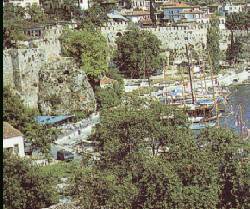
All the more persistent, however, were the attacks of the Slavic races. During
the time of Heraclius the Croats and Serbs established themselves in their present
homes. The Roman cities of Dalmatia had difficulty in defending themselves.
Presently the Slavs took to the sea, and by 623 they had pushed their way as
far as Crete. Still their visits were only occasional they made no permanent
settlements on the islands, and on the mainland the larger cities escaped subjection
to Slavic influence was attacked again and again most seriously in 675, but
was saved each time by the heroism of her citizens. The Slavs, fortunately,
were still split into different tribes, so that they could be held in check
by timely expeditions, such as that which Constans had made near Thessalonica.
It was otherwise with the Bulgarians. In 635 Heraclius concluded an alliance
with their prince, Kuvrat, so as to use them in opposing the Avars and Slavs.
However, there soon arose in the territory between the Danube and the Balkan
Peninsula, under the leadership of the Bulgarians a state composed of Slavonic
and Finnic-Ugrian elements. Their organization differed widely from that of
the Serbs and Croats, who were held together by no political bond. In 679 the
Emperor Constantine Pogonatus suffered a serious defeat at the hands of the
Bulgarians; by 695 things had come to such a pass that Justinian II reconquered
Constantinople through Bulgarian assistance. When Byzantium faced a three-sided
invasion from the Arabs, Avars, and Bulgarians in 717, the powerful leader Leo
III the Isaurian (717-741) came forward to save the empire. The Byzantines
triumphed by using new techniques such as Greek fire (invented by Callinicus),
a sort of medieval equivalent of napalm. The substance, a powerful chemical
mixture whose main ingredient was saltpeter, caught fire on contact with water
and stuck to the hulls of the Arabs' wooden ships. Over the next ten years,
Leo rebuilt those areas ruined by war and strengthened the theme system. He
reformed the law, limiting capital punishment to crimes involving treason. He
decreed the use of mutilation for a wide range of common crimes, a harsh but
still less extreme punishment than execution.
From the beginning, the
Byzantine emperors played active roles in the calling of church councils
and the formation of Christian doctrine.Leo the Isaurian took seriously
his role as religious leader of the empire. He vigorously persecuted heretics
and Jews, ordering that the latter must be baptized. In 726 he launched
a theological crusade against the use of icons, images or representations
of Christ and other religious figures. The emperor was concerned that
icons played too prominent a role in Byzantine life and that their common
use as godparents, witnesses at weddings, and objects of adoration violated
the Old Testament prohibition of the worship of graven images. Accordingly,
the emperor ordered the army to destroy icons. This image-breaking, or
iconoclastic, policy sparked a violent reaction in the western part of
the empire, especially in the monasteries. The government responded by
mercilessly persecuting those opposed to the policy. The eastern part
of the empire, centered at Anatolia, supported the breaking of the images.
By trying to remove what he considered an abuse, Leo split his empire
in two. |
 |
In Byzantium's single-centered society, this religious conflict had far-reaching
cultural, political, and social implications. In 731 Pope Gregory II condemned
iconoclasm. Leo's decision to destroy icons stressed the fracture lines that
had existed between east and west for the past four centuries, expressed in
the linguistic differences between the Latin west and the Greek east. Leo's
successors continued his religious and political policies, and in 754 Pope Stephen
II turned to the north and struck an alliance with the Frankish king Pepin.
This was the first step in a process that half a century later would lead to
the birth of the Holy Roman Empire and the formal political split of Europe
into the east and west.
There was a brief attempt under the regent, later empress, Irene (797-802),
in 787, to restore icons. Like Athenais, she was an Athenian. In 797 she gained
power after having her son - the rightful but incompetent heir, Constantine
VI, - blinded in the very room in which she had given him birth. Irene then
became the first woman to rule the empire in her own name (797-802). She could
neither win widespread support for her pro-icon policies, nor could she put
together a marriage alliance with the newly proclaimed western emperor Charlemagne,
a union which would have brought east and west together. As Irene spent the
treasury into bankruptcy, her enemies increased. Finally in 802, the grand treasurer,
Nicephorus put an end to her power, and she spent her remaining years on the
island of Lesbos in sickness and poverty.
Irene is honoured as a saint in the Greek Church because at the Seventh General
Synod of Nicaea (787), she obtained important concessions in the matter of the
veneration of images. Though the adoration of images, as well as other abusive
practices of veneration, which had already been condemned as idolatrous, were
again wholly forbidden, prostrate veneration, incense, and candles were permitted.
After the fall of Irene, the Iconoclasts again gained the upper hand, and the
brief reign of Michael I, who supplanted his brother-in-law Stauracius (811),
was powerless to change this.
The conflict over iconoclasm and Irene's ineptitude placed the empire in jeopardy
once again. Her successor, Nicepherous (802-811), after struggling to restore
the bases of Byzantine power, was captured in battle with the Bulgarians in
811. The Khan Krum beheaded him and had his skull made into a drinking mug.
Soon the iconoclasts made a comeback, but this phase of image-breaking lacked
the vigor of the first, and by 842 the policy had been abandoned.
The iconoclastic controversy marked a period when the split between east and
west became final. Eastern emperors were strongly impressed by Islamic culture,
with its prohibition of images. The emperor Theophilus (829-842), for example,
was a student of Muslim art and culture, and Constantinople's painting, architecture,
and universities benefited from the vigor of Islamic culture. This focus on
the east may have led to the final split with the west, but it also produced
an eastern state with its theological house finally in order and its borders
fairly secure by the middle of the ninth century.
The Emperor Theophilus
(829-42) in the vigour of his religious persecution approached the energetic
Constantine V (741-75), known to the opposite party, and later to historians,
by the insulting epithet of Copronymus. When Theodora became regent, through
the early death of her husband, she introduced milder measures. A compromise
was effected between the parties. At the synod of 843 permission was given for
the veneration of images, and at the same time the anathema was removed from
the name of the Emperor Theophilus. This day is celebrated by all Orthodox christians
as Sunday of Orthodoxy - Kyriaki tis Orthodoxias.
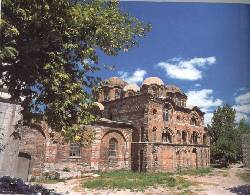 Missionaries from Constantinople set out in the 860s to convert the Bulgarian
and Slavic peoples and in the process organized their language, laws, esthetics,
political patterns, and ethics, as well as their religion. But such transformation
did not take place without struggle. Conflict marked the relationship between
the Roman and Byzantine churches. The most significant indication of this competition
was seen in the contest between the Patriarch
Photius and Pope Nicholas I in the middle of the ninth century.
Missionaries from Constantinople set out in the 860s to convert the Bulgarian
and Slavic peoples and in the process organized their language, laws, esthetics,
political patterns, and ethics, as well as their religion. But such transformation
did not take place without struggle. Conflict marked the relationship between
the Roman and Byzantine churches. The most significant indication of this competition
was seen in the contest between the Patriarch
Photius and Pope Nicholas I in the middle of the ninth century.
Photius excelled both as a scholar and religious leader. He made impressive
contributions to universities throughout the Byzantine empire and worked to
increase the area of Orthodoxy's influence. Nicholas was his equal in ambition,
ego, and intellect. They collided in their attempts to convert the pagan peoples
such as the Bulgarians, who were caught between their spheres of influence.
The Bulgarian Khan Boris, as cunning and shrewd as either Photius or Nicholas,
saw the trend toward conversion to Christianity that had been developing in
Europe since the sixth century and realized the increased power he could gain
by the heavenly approval of his rule. He wanted his own patriarch and church
and dealt with the side that gave him the better bargain. Between 864 and 866
Boris changed his mind three times over the issue of which holy city to turn
to. Finally, the Byzantines gave the Bulgarians the equivalent of an autonomous
church, and in return the Bulgarians entered the Byzantine cultural orbit. The
resulting schism between the churches set off a sputtering sequence of Christian
warfare that went on for centuries.
The work of the Byzantine
missionaries Cyril and Methodius was more important than Bulgarian ambitions
or churchly competition. The two, who were brothers, were natives of Thessalonica.
They learned the Slavic language and led a mission to Moravia, which was ruled
by King Rastislav. The king no doubt wanted to convert to Orthodoxy and enter
the Byzantine orbit in order to preserve as much independence for his land as
he could in the face of pressure from his powerful German neighbors. Cyril and
Methodius went north, teaching their faith in the vernacular Slavic language.
Cyril devised an alphabet for the Slavs, adapting Greek letters. The two brothers
translated the liturgy and many religious books into Slavic. Although Germanic
missionaries eventually converted the Moravians by sheer force, the efforts
of Cyril and Methodius profoundly affected all the Slavic peoples, whose languages
are rooted in the work of the two brothers.
During this whole period the Bulgarians had given great trouble to the Byzantine
Empire. Equally violent were the wars against the Saracens and the Slavs. There
was no second investment of the capital by the Syrian Arabs, it is true, though
on the other hand, in 860 the city was hard pressed by the Varangian Ros, but
all the more danger was to be apprehended from the Arabs who had been expelled
from Spain and had settled in Egypt in 815. In 826 they conquered Crete, and
about the same time the Arabs of Northern Africa began to settle in Sicily,
a migratory movement which finally resulted in the complete loss of the island
to the Byzantines. As once they had come from Syria and Asia Minor so now many
Greek families migrated to Lower Italy and the Peloponnesus. The Christianization
and Hellenization of the Slavs was now begun, and soon produced rich fruits.
For two centuries, roughly coinciding with the reign of the Macedonian dynasty,
Byzantium enjoyed political and cultural superiority over its western and eastern
foes. Period of Macedonian Dynasty (867-1057) was a period of the highest
development of Byzantine power. Western Europe staggered under the blows dealt
by the Saracens, Vikings, and Magyars. The Arabs lost the momentum that had
carried them forward for two centuries. Constantinople
enjoyed the relative calm, wealth, and balance bequeathed by the theme system
and promoted by a series of powerful rulers. The time was marked by the flowering
of artists, scholars, and theologians as much as it was by the presence of great
warriors. It was during this golden age that Constantinople made its
major contributions to Eastern Europe and Russia.
The founder of the Dynasty, from Adrianople, was Vasileus I who attracted the
notice of a high official by his powerful build and his athletic strength and
later gained the favour of the dissolute emperor
Michael III, the last of the Phrygian emperors. Basil was also a favourite
with women. His relations with the elderly Danielis of Patras, whom he had met
whilst in the retinue of his master laid the foundations of Basil's fortune.
He became emperor in 23 September 867. He was the father of Leo
VI, the Wise (886-912) who wrote sixty books about the Code of the Basilica.
Basil I and Leo VI oversaw the collection and reform of the law codes. Leo,
the most prolific lawgiver since Justinian, sponsored the greatest collection
of laws of the medieval Byzantine empire, a work that would affect jurisprudence
throughout Europe. Constantine VII Porphyrogenitus (912-959) excelled
as a military leader, lover of books, promoter of an encyclopedia, and surveyor
of the empire's provinces.
Byzantium continued its military as well as its theological intensity. Arab armies made continual thrusts,
including one at Thessalonica (second city of the empire) in 904 that led to the Byzantine loss
of 22,000 people through death or slavery. The most important was the final loss of Sicily to the Saracens
in 878 Syracuse fell, and in 902 Tauromenium, the last Byzantine stronghold on the island, was taken by
the Arabs. But during the tenth century the combination of the decline in Muslim combativeness and the
solidarity of Byzantine defenses brought an end to that conflict.
Basil II (976-1025), surnamed Bulgaroctonus, or
Bulgar-slayer, stopped the Bulgarians at the battle of Kleidi on 29th July 1014.
The emperor celebrated his victory with imposing ceremonies in the church of Panagia at
Athens (the old Parthenon) and the Greek Empire stood on a height it was never again to reach.
Basil II proved as
capable a military leader as his two predecessors Nicephorus
II Phocas (963-969) and John Tzimisces (969-976).
At the same time, the Macedonian emperors dealt from a position of strength with western European powers,
especially in Italy, where their interests clashed. Western diplomats visiting the Byzantine court expressed
outrage at the benign contempt with which the eastern emperors treated them, but this conduct merely
reflected Constantinople's understanding of its role in the world.
By the eleventh century,
succession to the Byzantine throne had degenerated into a power struggle
between the civil and military aristocracies. On the other hand, the secular
and theological universities flourished despite the political instability,
and the emperors proved to be generous patrons of the arts. At a time
when scholarship in western Europe was almost nonexistent, Byzantine society
featured a rich cultural life and widespread literacy among men and women
of different classes. |
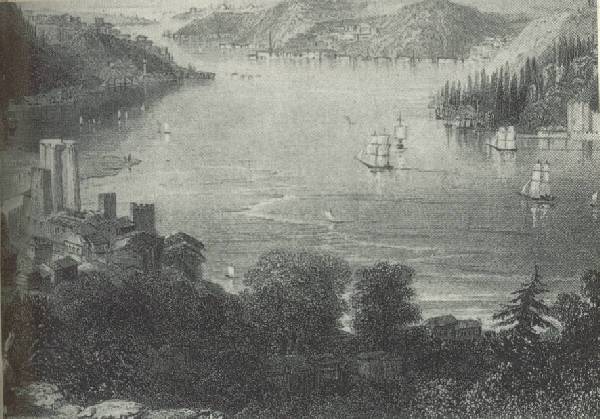 |
The greatest contribution to Western civilization made during the golden age
was the preservation of ancient learning, especially in the areas of law,
Greek science, Platonic and Aristotelian philosophy, and Greek literature.
Unlike in the West where the church maintained scholarship, the civil servants
of Constantinople perpetuated the Greek tradition in philosophy, literature,
and science. Byzantine monasteries produced many saints and mystics and showed
interest in learning and teaching.
Vasileus' brother, Constantine VIII (1025-1028), ruled for three years. He left
three daughters: Evdokia, Zoe and Theodora. Zoe (1028-1050) was forty-eight
years of age at the death of her father, but even after that married three times.
Zoe's three husbands Romanus III, Argyrus (1028-1034), Michael IV (1034-1041),
and Constantine IX, Monomachus (1042-1054) all came from the higher bureaucratic
circles. Theodora, on the death of her sister and her last surviving brother-in-law,
assumed the reins of power, and not unsuccessfully (1054-1056). On her deathbed
she transferred the purple to the aged senator Michael VI, Stratioticus (1056-1057).
This was the signal for the military power to protest. The holders of great
landed estates in Asia Minor gave the power instead to one of their own faction.
Isaac I, Comnenus, inaugurates a new era.
Under heroes like Georgius Maniaces, and Harold Hardrada, it is true, headway
was made against the most various foes. But after 1021 Armenia, which had reached
a high state of prosperity under the rule of the Bagratides, and had been annexed
to Byzantine territory by Basil II and Constantine IX, gradually passed under
the sway of the Seljuk Turks, and after 1041 Lower Italy was conquered by the
Normans. This is the first appearance of the two foes who were slowly but surely
to bring about the destruction of the empire, and the worst feature of their
case was that the Greeks themselves prepared the way for their future destroyers.
Rich families invested their wealth in landed possessions, and the poorer population
had to make way for them. This decline of the peasantry resulted to the decline
of the military strength. Empires more often succumb to internal ailments than
to external takeovers and this was the case with the Byzantine empire. As long
as Constantinople strengthened the foundations laid by Heraclius - the theme
system and reliance on the free peasant-soldier - the empire withstood the military
attacks of the strongest armies. When the Byzantine leaders abandoned the pillars
of their success, the empire began to falter. Land came to be the most profitable
investment for the rich, and the landowning magnates needed labor. As prices
went up, taxes followed. The peasant villages were collectively responsible
for paying taxes, and the rising tax burden overwhelmed them. In many parts
of the empire, villagers sought relief by placing themselves under the control
of large landowners, thus taking themselves out of the tax pool and lowering
the number of peasant-soldiers. Both the state treasury and the army suffered.
Some emperors tried to change this situation. Romanus I, Lacapenus, devised
legislation against the further extension of the landed interests and he was
followed by Constantine VII Porphyrogenitus, Romanus II, and Nicephorus II,
Phocas. Nicephorus II, who was descended from a Cappadocian family, opposed
the great land proprietors and the further extension of ecclesiastical property.
He lived an austere military life. After the death of his wife and his only
son always wore a hair shirt, never ate meat, and slept on the bare floor.
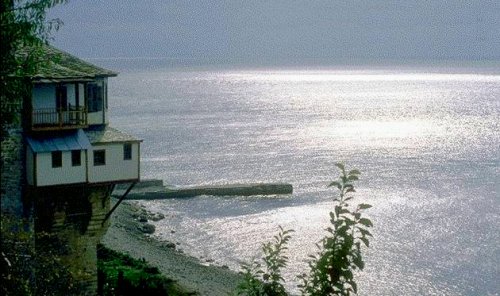 Ecclesiastical, particularly monastic, holdings had gradually begun to absorb
the estates of smaller land-holders. These measures against the Church were
one of the causes of the fall of old Nicephorus and of the elevation of light-hearted
young Ioannes Tzimisces to the throne. Still, even under John Tzimisces and
Basil II, the struggle of the great landed interests continued. It was only
the reaction after the death of Basil that gave the aristocratic party the final
victory. It gained strength under the regime of the civilian emperors. Ultimately
this party was strong enough to decide the succession to the imperial crown.
Ecclesiastical, particularly monastic, holdings had gradually begun to absorb
the estates of smaller land-holders. These measures against the Church were
one of the causes of the fall of old Nicephorus and of the elevation of light-hearted
young Ioannes Tzimisces to the throne. Still, even under John Tzimisces and
Basil II, the struggle of the great landed interests continued. It was only
the reaction after the death of Basil that gave the aristocratic party the final
victory. It gained strength under the regime of the civilian emperors. Ultimately
this party was strong enough to decide the succession to the imperial crown.
The powerful body of landed proprietors were of advantage to the empire in one
particular. Since the decline of the old military organization they upheld the
military prestige of the empire. For that very reason a council of the landed
proprietors of Asia Minor raised Isaac Comnenus (1057-1059), much against his
will, to the throne. Isaac regarded the crown as a burden. Weary of strife with
the senatorial aristocracy, he soon gave up the sceptre and retired to the monastery
of Studium. He considered himself defeated and accordingly designated as his
successor not his capable brother John, and his sons, but an official high in
the civil service, Constantine X, Ducas (1059-1067), a man who during Isaac's
brief reign had greatly assisted the emperor, who was wholly unversed in affairs
of administration. This meant a fresh victory for the civil bureaucracy, who
signalized their accession to power by setting aside army interests, and even
the most pressing requirements for the defense of the empire. This naturally
led to a severe retribution, and as a consequence popular sympathy reverted
to the military party. At the death of Constantine, the widowed Empress Evdocia
took a step decisive for the fate of the empire by recognizing the need and
choosing as her husband Romanus
IV Diogenes (1068-1071), an able officer and one of the heroic figures of
Byzantine history.
In 11th century a new foe arose, moving haphazardly across the empire and pillaging
the rich cities of Minor Asia. When the Seljuk Turk leader Alp Arslan ("Victorious
Lion") made a tentative probe into the empire's eastern perimeter near Lake
Van in 1071, the multilingual mercenary army from Constantinople fell apart
even before fighting began at the battle of Manzikert. With the disintegration
of the army, the only limit to the Turks' march for the next decade was the
extent of their own ambition and energy.
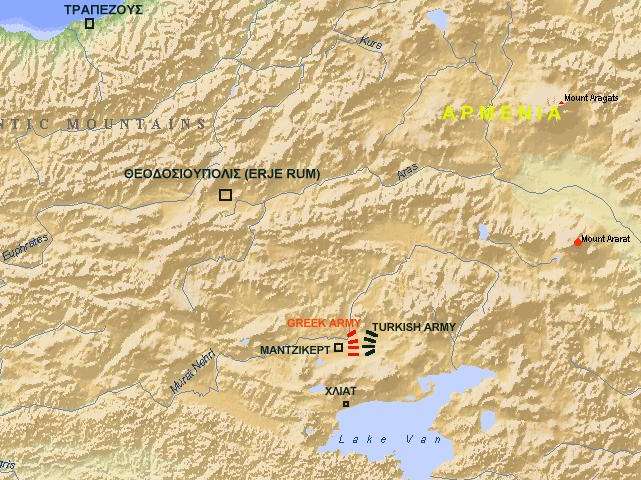 Byzantium lost the heart of its empire, and with it the reserves of soldiers,
leaders, taxes, and food that had enabled it to survive for the past four centuries.
From its weakened position, the empire confronted Venice, a powerful commercial
and later political rival. By the end of the eleventh century, the Venetians
took undisputed trading supremacy in the Adriatic Sea and turned their attention
to the eastern Mediterranean. The Byzantines also faced the challenges of the
Normans, led by Robert Guiscard, who took the port of Vari, the last Byzantine
stronghold in Italy. Romanus was killed by his internal enemies in the most
barbarous manner, and after four years the government again fell into the hands
of the civil party. Michael VII, Parapinaces (1071-78), the pupil of Psellus,
was raised to the throne. Soon the crisis became so serious that another military
emperor was placed on the throne Nicephorus III, Botaniates (1078-1081). The
old man however, was unable to bring order out of the universal chaos.
Byzantium lost the heart of its empire, and with it the reserves of soldiers,
leaders, taxes, and food that had enabled it to survive for the past four centuries.
From its weakened position, the empire confronted Venice, a powerful commercial
and later political rival. By the end of the eleventh century, the Venetians
took undisputed trading supremacy in the Adriatic Sea and turned their attention
to the eastern Mediterranean. The Byzantines also faced the challenges of the
Normans, led by Robert Guiscard, who took the port of Vari, the last Byzantine
stronghold in Italy. Romanus was killed by his internal enemies in the most
barbarous manner, and after four years the government again fell into the hands
of the civil party. Michael VII, Parapinaces (1071-78), the pupil of Psellus,
was raised to the throne. Soon the crisis became so serious that another military
emperor was placed on the throne Nicephorus III, Botaniates (1078-1081). The
old man however, was unable to bring order out of the universal chaos.
In 1081 the Comnenian family claimed the Byzantine throne. In an earlier time,
with the empire in its strength this politically astute family might have accomplished
great things. In the eleventh and twelfth centuries, though, the best they could
do was play a balance-of-power game between east and west. Alexium
Comnenus (1081-1118), founded the last of the great dynasties, which was
to give the empire three more brilliant rulers, Alexius I, John II, and Manuel.
It was a period of restoration. Men hoped again to raise literature to the standard
of the classic authors and to revive the ancient language and thus they hoped
to restore the glory of the Roman Empire. Moreover, the economic administration
of both public and private business was admirable during this period.
But never, was the empire in a more precarious position, despite all its outward
splendour. Enemies from the West, Normans had conquered the greek provinces
of Kalavria, Apoulia in south Italy, from the East Turks devastated Minor Asia -
Mikra Asia, and from the north Slavs, Bulgarians, Magyars, Petchenegs,
and Cumani threatened Macedonia and Thrace. The Byzantine army had lost its
glory as foreign mercenaries had replaced the native troops. Saddest of all
was the decay of the fleet. The Greek Empire was dependent on the allied Italian
seaports. Still, not a little was achieved. Clever diplomacy replaced actual
power, and succeeded in preserving for some time the Byzantine Supremacy.
 This period also marked the beginning of the Norman raids on the Balkan Peninsula.
Between 1081 and 1085 Epirus and Thessaly were threatened by Robert Guiscard
and his son Bohemund, who were twice defeated in naval encounters by the Byzantines
in league with the Venetians. On land, however, they proved their superiority
in several places, until the death of the elder Guiscard put an end to their
projects and gave the Byzantine State half-a-century of peace in that direction.
After that period, however, the raids were renewed. In 1147 Thebes and Corinth
were taken by King Roger, on which occasion many silk-weavers were deported
to Sicily. In 1185, at the command of King William II of Sicily Thessalonica
was reduced to ashes. To the north, the outlook was no brighter. The Byzantine
State was successful it is true, in keeping the Serbs in nominal subjection,
and in entering into diplomatic and family relations with the royal family of
Hungary, but the Bulgarians finally broke loose from Byzantine control.
This period also marked the beginning of the Norman raids on the Balkan Peninsula.
Between 1081 and 1085 Epirus and Thessaly were threatened by Robert Guiscard
and his son Bohemund, who were twice defeated in naval encounters by the Byzantines
in league with the Venetians. On land, however, they proved their superiority
in several places, until the death of the elder Guiscard put an end to their
projects and gave the Byzantine State half-a-century of peace in that direction.
After that period, however, the raids were renewed. In 1147 Thebes and Corinth
were taken by King Roger, on which occasion many silk-weavers were deported
to Sicily. In 1185, at the command of King William II of Sicily Thessalonica
was reduced to ashes. To the north, the outlook was no brighter. The Byzantine
State was successful it is true, in keeping the Serbs in nominal subjection,
and in entering into diplomatic and family relations with the royal family of
Hungary, but the Bulgarians finally broke loose from Byzantine control.
In 1096, the first crusaders appeared, partially in response to the Council of Clermont, partially in
response to the opportunity for gold and glory. Alexius had appealed to Pope Urban II for help against the
Turks, but the emperor had not bargained on finding a host of crusaders, including the dreaded Normans, on
his doorstep. The First Crusade brought about two important results: the victory of the crusaders
at Dorylaeum (1097) brought the western part of Asia Minor directly under Byzantine control, and Antioch
indirectly, through the oath of fealty exacted of Bohemund (1108); the Second Crusade, during which the
Emperor Manuel allied himself with the Emperor Conrad III (1149), neutralized the power of the Italian
Normans. Manuel now conceived far-reaching plans. He
avenged King Roger's incursion into central Greece (1147) by the recapture of Corfu (1149) and the
occupation of Ancona (1151), in this way becoming a factor in Italo-German complications. He actually
dreamed, as Justinian had, of reestablishing the Roman Empire of the West. These ambitious demands found no
favour with the popes, with whom since the quarrel about the Norman possessions in South Italy, under the
Patriarch Michael Cerularius (1054), a final rupture had taken place. Thus the undertaking resulted
in failure. Great offence had been given to the emperor Frederick Barbarossa, which became manifest when
he allied himself with the Seljuk Turks and the Sultan of Egypt. Byzantium also reaped great advantage from
the establishment of the principalities of the crusaders in Syria. The invasion of the East by the
crusaders also brought new dangers, which grew constantly more menacing. Even before this the constant
and manifold intercourse between the empire and the Italian maritime states as well as the settlement of
the Amalfians, Pisans, Genoese and Venetians in Byzantine cities, had involved many inconveniences. It is
true that the victory over the Normans in the campaign of 1081-85 was gained with the aid of the Venetians,
but by 1126 war was in progress with Venice. The commercial republics of Italy grew constantly more arrogant,
demanding trading privileges as payment for aid rendered by them, and retaliating for any slights by
hostile invasions. It was only the rivalries of the Italian cities that enabled the Byzantines to maintain
their supremacy in their own country. As a matter of fact, the Italians had long regarded the empire merely
as their prey, and so it was inevitable that the hatred of the Greek nation should be slowly gathering strength.
The Fourth Crusade ended the period of Byzantine glory.
The Venetians controlled the ships and money for this crusade and persuaded the fighters to attack the
Christian city of Zara in Dalmatia - a commercial rival of Venice - and Constantinople before going on to
the Holy Land. Venice wanted a trade monopoly in the eastern Mediterranean more than a fight with the
Muslims. Constantinople was paralyzed by factional strife, and for the first time, an invading force
captured the city and devastated it far more than the Turks would 250 years later. A French noble described
the scene:
"The fire...continued to rage for a whole week and no one could put it out....
What damage was done, or what riches and possessions were destroyed in the flames was beyond the power of
man to calculate....The army...gained much booty; so much, indeed, that no one could estimate its amount
or its value. It included gold and silver, table-services and precious stones, satin and silk, mantles of
squirrel fur, ermine and miniver, and every choicest thing to be found on this earth...so much booty had
never been gained in any city since the creation of the world."
The Venetians made sure they got their share of the spoils, such as the
bronze horses now found at St. Mark's Cathedral in Venice,
and played a key role in placing a new emperor on the throne. The invaders ruled Constantinople until 1261.
The Venetians put a stranglehold on commerce in the region and then turned their hostility toward the Genoese,
who threatened their monopoly.
The Greek Empire continued to exist with Nicaea as its capital. Capable rulers as
Theodore I, Lascaris (1204-22), John III, Vatatzes (1222-54), and Theodore II, Lascaris (1254-58),
brought back prosperous times to the empire. The Greeks were
able not only to make a brave stand against the Franks, but to
expel them again from Constantinople,
a task which was all the more difficult because at that time the Greek nation
had undergone a dismemberment from which it never recovered. Two other states had been founded:
the Empire of Trebizond, under the Comneni, which survived the fall of the capital on the Bosphorus (1453)
for some years, and the state of Epirus with Arta as its capital.
However it was impossible to drive completely the Franks from Byzantine soil.
Split up into various minor principalities after the recapture by Greeks of Thessalonica (1222) and
Constantinople (1261), they settled in the central part of Greece and in the Peloponnesus, in Crete,
Euboea, Rhodes, and the smaller islands.
After the Sicilian Vespers (1282) the Byzantine Empire was no longer menaced directly by the Latin peril.
The Byzantines were gradually entering into a new relationship with the West. They started to send envoys
seeking protection from the danger who was approaching from the East. But of course the reunion of the
churches was a condition of this aid, which, as at an earlier period, was vehemently opposed by the people.
This opposition was made manifest whenever there was any question of union with Rome from political motives.
The Paleologus Dynasty (1261-1453), had the misfortune to rule the empire during its final two centuries.
The solidus, the Byzantine coin which had resisted debasement from the fourth through the eleventh century,
now fell victim to inflation. The church, once a major support for the state, became embroiled in continual
doctrinal disputes. Slavic peoples such as the Serbs, who had posed no danger to the empire in its former
strength became threats. During the reigns of Stephen Urosh II, Milutin (1281-1320), and
Stephen Dushan (1321-55), it seemed as though the Serbs were about to realize the old dream of the Bulgars,
of a Byzantine Empire under Slavonian rule. It was not easy for the Greeks to maintain themselves against so many
enemies for two and a half centuries, and it often appeared as though the end had come.
Blessed after 1296 with a strong line of male successors and good fortune, the Ottoman-Turks rapidly
expanded their power through the Balkans. They crossed the Straits into Europe in 1354 and moved up the
Vardar-Morava valleys to take Serres (1383), Sofia (1385), Nish (1386), Thessalonica (1387), and finally
Kossovo from the South Slavs in 1389. The Turks won their victories by virtue of their overwhelming
superiority in both infantry and cavalry. Whole cities were transformed in ashes and a civilization who
survived for thousands years perished. Thousands of christians became musulmans in order to save
their head. Young boys were taken by their parents for the turkish army (jenissaries) and thousands
of girls were taken to the harems. Churches became mosques, schools and libraries were burnt down
from a people who was illiterate and sauvage.
In response to the Ottoman advance, the west mounted a poorly conceived and ill-fated crusade against the
Turks at Nicopolis on the Danube in 1396 that led to the capture and slaughter of 10,000 knights and their
attendants. The final catastrophe was temporarily averted by an almost fortuitous event, the victory of
Timur-Leng over the Turks near Ancyra (1402). This storm quickly passed over; but soon Constantinople was
again on the verge of capture (1422).
The Emperor John VIII (1423-48) once more attempted to effect a
union at Florence (1439). After some preliminary victories, however, defeat ensued near Varna, 1444.
The quarrels of various pretenders to the throne and the lack of unity among those in power within the
city precipitated the final catastrophe. The end came finally in May 1453.
The last emperor, Constantine XI, led
his forces of 10,000, half of whom were Italians, to hold off the 200,000 Turks
for seven weeks. Finally, the Ottomans, with the help of Hungarian artillerymen, breached the walls of the
beleaguered city. After 1123 years, the Christian capital fell. The Turks slaughtered, raped, destroyed as
many as they could. The barbarians didn't respect anything, holy icons, books, paintings, mosaics
all these were destroyed. They demolished and vandalized churches, ancient monuments, palaces dated
from 4th century.
The Fall of the Byzantine Empire, A chronicle by George Sphrantzes translated by Marios Phillipides
Our greatest and holiest Church of Saint Sophia, the earthly
heaven, the throne of God's glory, the vehicle of the cherubim
and second firmament, God's creation, such edifice and
monument, the joy of all earth, the beautiful and more beautiful
than the beautiful became a place of feasting; its inner
sanctum was turned into a dining room, its holy altars
supported food and wine, and were also employed in the
enactment of their perversions with our women, virgins, and
children"
Nevertheless the ideas did not vanished. Turks didn't manage to vanish the Hellenic spirit.
Many Greeks like Byssarion, Dimitrios Kavakis, Georgios Xaritonimos, Ieronimos of Sparta fled to Europe
where they spread the ideas of Socrates, Platon, Aristotelis, Aeschylus, Archimidis, Homer, Euripides,
Sophocles, Solon.
European renaissance followed and laid the basis of the modern European culture. Also, Europe was now
militarily ready to protect her cities from any attempt from the barbarian hordes to conquer them.